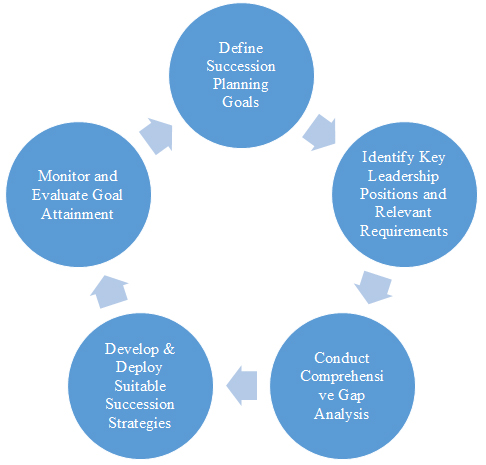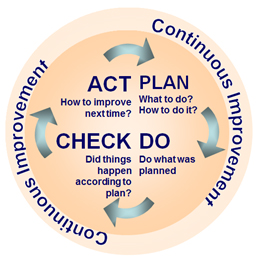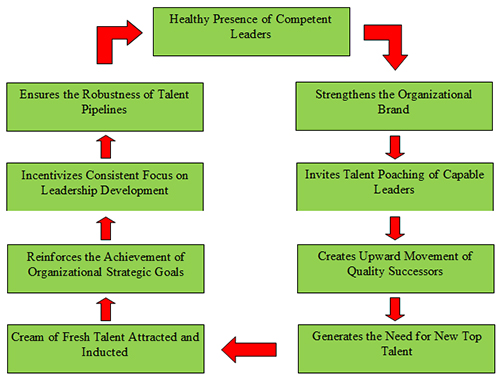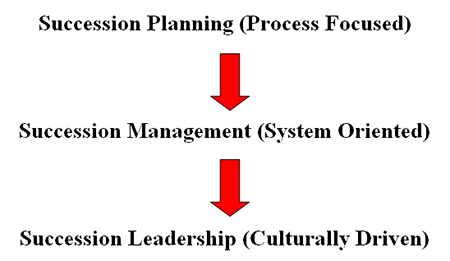Discovering the World Beyond Succession Planning
By Murad Salman Mirza
Succession planning is increasingly being viewed as an organizational imperative to ensure timely availability of qualified and competent candidates who can take up the reins of critical leadership positions upon the availability of relevant vacancies. It is generally seen as a proactive measure that marginalizes ‘replacement planning’ and hedges against the risk of a ‘leadership vacuum’ to ensure a steady stride in achieving strategic goals and objectives.
Generally, key steps in the respective context are:
Core Phases of Succession Planning

THE CHALLENGE
The aforementioned initiatives are often hampered by a heavily skewed focus on streamlining the process of succession planning. Normally, this is reinforced by relying on the efficacy of the following aligned functional processes for producing ‘suitable’ potential successors from the available talent pool:
- performance management
- reward and recognition
- training and development
However, this frequently alienates other functional processes necessary for the robustness of talent pipelines that are the backbone of a productive talent management system. The trivialized functional processes in the respective context include:
- hiring and orientation
- career guidance and progression,
- employee relations and engagement, and
- employee exit m
Let’s ponder these trivialized elements within the realm of talent management as follows:
Hiring and Orientation
This is the key entry point into an organization and has a ‘ripple effect’ for the other functional processes in terms of adjusting to the quality of the inducted talent. Mostly, organizations focus on the fulfillment of the available vacancy by emphasizing direct requirements; however, this ‘short sightedness’ often overlooks the prospect of employing ‘potential successors’ who have the basic ingredients that can be nurtured into the desired leadership traits.
This foresight is required by both the HR/talent management function and the relevant line manager with the unambiguous support of senior management dedicated to a progressive working environment. Otherwise, the adage of ‘garbage in, garbage out’ will create unhealthy reverberations throughout the organization and exacerbate the leadership crisis by straining the functional processes of performance management, reward and recognition, and training and development.
It requires proactively synchronizing desired traits with the specifications of the highest position that can be attained within the relevant career path and astutely using onboarding to inculcate a conducive mindset—one which manifests into meeting/exceeding behavioural and job performance expectations as a treasured member of the organization. In the words of Stephen Covey, ‘Begin with the End in Mind.’
Career Guidance and Progression
There comes a stage in every employee’s work life when he/she starts confronting their ‘career fears,’ and indulges in matching their own priorities with those of the organization to see if it makes sense to stay with his/her current employer or look for better prospects elsewhere. Such ‘cost-benefit’ calculations are a particular challenge for talent managers who need to ensure that the ‘high potentials’ (HIPOs) do not opt for leaving the organization—as this causes major disruptions with respect to the succession planning initiatives.
This can become an acute problem, especially if exacerbated by the following factors:
- uncertain economic environment;
- disruptive changes in top leadership;
- emergence of agile competitors;
- acidic organizational politics;
- inevitable family pressures; and
- corrosive relationships between supervisors and high potentials.
Therefore, it becomes imperative for organizations to implement strategies that ensure minimization of talent attrition, especially, among those considered to be top prospects for critical senior positions. This can include:
- timely mentorship from influential senior managers;
- frequent informal interactions;
- customizing benefits package within available resources;
- encouraging productive interaction at suitable professional forums with peers; and
- healthy exposure to growth opportunities.
In the words Franklin D. Roosevelt, “The only limits to our realization of tomorrow will be our doubts of today.”
Employee Relations and Engagement
Prodigious talent requires a healthy and supportive work environment for sustained excellence. Consequently, high potentials can be very demanding and persuasive as they realize the true extent of their worth to the organization. While organizations try to ensure that such ‘prized assets’ are secured against poaching from ravenous competitors—and continue steadily on the available career path through insightful engagement strategies—there is also an increased prospect of ‘class warfare’ with respect to ‘talent differentiation’ which can be waged by peers who feel marginalized. Their ‘internal dissonance’ can compel them to create an unfavourable work environment for high potentials by resorting to Machiavellian tactics.
This can have a debilitating impact on harmonious employee relations as a rampant grapevine takes precedence over ‘ground realities,’ and everyone jostles for reliable allies within the senior management/power brokers to secure their future. Succession planning suffers greatly in such situations and often requires rescue through timely intervention from the top in terms of visibly supporting the functional head responsible for cultivating the next crop of suitable leaders for the organization.
In the words of Maya Angelou, “I’ve learned that people will forget what you said, people will forget what you did, but people will never forget how you made them feel.’
Employee Exit Management
One of the most overlooked functional processes within the realm of talent management is the way in which departures are handled within organizations and how it impacts the potential successors. This varies a great deal in accordance with the specific circumstances that prompt the departure of an employee. For example, someone retiring after a long and distinguished career is generally given a fond farewell that can include a party peppered with emotional speeches and evocative mementos; on the other hand, someone who is fired may not even be accorded the ‘privilege’ of an Employee Exit Interview/Survey/Questionnaire to gain insightful feedback.
Such marked differences in the application of divergent procedures resonate with employees in different ways. Consider that high potential peers of a fired employee might feel increasingly insecure if the reason for their colleague’s firing doesn’t register with them as a serious transgression—and instead, they consider it an act to ‘cleanse’ the workforce by influential quarters as a consequence of an internal power struggle with rival factions. Consequently, they may be forced to think about the ‘shaken’ security of their career progression and contemplate the possibility of exiting in a more dignified manner.
Measures to counter such deeply rooted misgivings need to be handled very delicately since such ‘psychological bruises’ are rarely highlighted on any formal forum and tend to linger in whispers between the corridors of power. In the words of Peter Drucker, ‘The most important thing in communication is hearing what isn’t said.’
THE WAY FORWARD
The aforementioned examples provide a sampling of tantalizing challenges that can derail even the best of intentions behind succession planning initiatives. Therefore, it is prudent to do periodic ‘quality assurance’ of the succession planning process and take necessary corrective/preventive actions in a timely manner followed by an impartial and honest review to curtail any derailment from strategic imperatives.
A more comprehensive and fruitful strategy would be to embrace and incorporate systems thinking in terms of upgrading and synchronizing all the interrelated functional processes (i.e., move from succession planning to succession management.) This would involve the establishment of service level agreements, backed by appropriate policies/procedures, between process owners that include clear performance expectations reflected through the relevant KRAs and KPIs, at the point of ‘handshaking’ with each other. The following illustration depicts the respective transition:

The efficiency and effectiveness of the functional processes involved at both the aforementioned stages can be refined by utilizing the following Deming Cycle:

The aforementioned approach ensures that an organization gains more stability, reliability and consistency in its relevant functional processes to deliver the expected level of performance with respect to succession initiatives and thrives under a strengthened talent management system. This should be ultimately taken to an ever higher level of excellence where the claims for being ‘world class’ can hold merit. Such a status can be achieved by planting the roots of succession within the corporate values espoused by the organization. Thus, identifying, developing and grooming potential leaders becomes an ‘ingrained exercise’ woven within the fabric of organizational culture. This enables the establishment of an ‘embedded nursery’ for producing skilled leaders who are not only critical to ensuring a bright future for the organization, but also, become worthy ambassadors of the organizational brand. Such a move also converts the risks associated with having competent leaders into competitive advantages; talent poaching is embraced instead of being feared when there is no shortage of skilled successors within the ranks, and ‘fresh blood’ flows through the corporate veins ensuring long term vitality, agility and relevancy in an increasingly unforgiving corporate world. This can be visualized through the following graphic:
The Talent Magnet Cycle

Consequently, an organization should eventually strive to achieve the position of ‘succession leadership’ that goes beyond ‘succession management’ and is illustrated as follows:

Such a status elevates an organization to being a role model not only within its own industry, but also in the wider corporate world as an enviable focus for benchmarking.
THE PARTING WORD
Evolution is a natural phenomenon, and organizations that are prepared to synchronize their development with the changing times are the ones with the best probability of assuring continued prosperity. While others languish and anguish over the question of survival, progressive organizations driven by enlightened leaders continue to redefine the boundaries of success with the help of capable potential successors.
In the words of Tom Peters, “Leaders don’t create followers, they create more leaders.”
Murad Salman Mirza is an innovative thinker and an astute practitioner of areas within and associated with the fields of Organisational Development, Talent Management and Business Transformation. He has lived, studied and served in different regions of the world, including the US, Australia, South Asia and the Middle East. Murad has more than 15 years of multi-disciplinary experience and has rich exposure to multiple sectors within the corporate world. Currently, he is engaged as a Board Member with two US-based organizations. His LinkedIn profile can be viewed at: Murad Salman Mirza.






